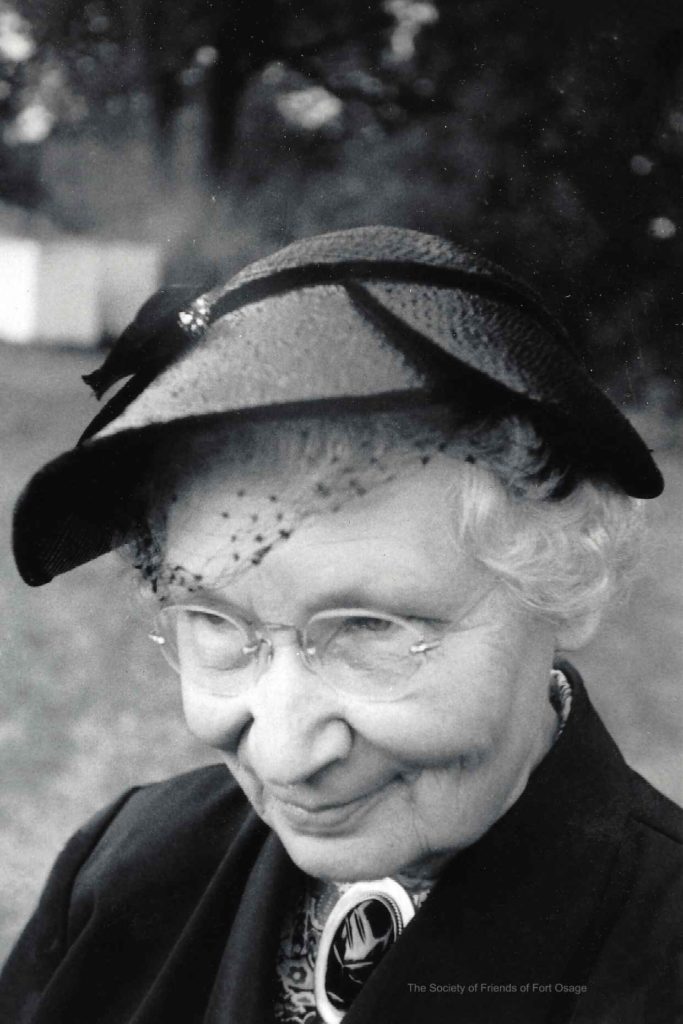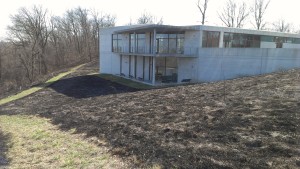… this is one of the finest historical restorations of its kind west of the Mississippi River.
Letter from the National Park Service to Ray G. Cowan, Presiding Judge, Jackson County Court, December 6, 1956
Rediscovering the Fort (1833-1940)
Although it closed in 1827, interest in the Fort Osage site began within just a few years. Prince Maximilian, with Karl Bodmer, noted during their famous journey up the Missouri River in 1833: “…we proceeded slowly, and reached, at dusk, the hill, on the right bank, where Fort Osage, built, in 1808, by Governor Lewis, formerly stood.”
Local curiosity was revived in 1908 when the Kansas City Star published a full-length article commemorating Fort Osage’s centennial. Less than a year later, in 1909, the Daughters of the American Revolution erected a monument to the Santa Fe Trail on the southeast edge of the Sibley Cemetery. In 1926, the D.A.R. also erected a memorial tablet nearby at Hayes Park that read, “In memory of the Lewis and Clark Expedition and establishment of Fort Osage…”

A bill was proposed to the Missouri legislature in 1932, to create a state park on the site of Fort Osage, as Jackson County had no state parks at that time. This bill was not passed. However, interest in the creation of a park was ignited again just a few years later when historian and Lindenwood College professor, Kate Gregg, published William Clark’s journal on the founding of Fort Osage, Westward with Dragoons (1937).
The year 1940 was a pivotal year in the rediscovery of Fort Osage. Two important events happened. First, Kate Gregg published, “The History of Fort Osage,” in the Missouri Historical Review, which remains to this date the most important publication on the history of the fort. Second, Dr. Gregg delivered a lecture to the Native Sons of Kansas City in which she strongly encouraged the reconstruction of Fort Osage.
With renewed public interest, the Native Sons of Kansas City called a meeting in April 1940 to: “investigate and promote the purchase of the site of Fort Osage and the restoration in complete historical detail of the original fort and trading buildings.”
The Native Sons even met briefly with First Lady, Eleanor Roosevelt, on April 12, 1940, at Union Station during a brief layover to request her assistance with the restoration project.
Jackson County then purchased a 14-acre tract surrounding the fort’s location early in 1941. Fort Osage was established as one of the earliest county parks, and the first county park to be operated as an historic site. However, it wasn’t until after World War II that park development began in earnest.
Archaeology of the Fort Site (1941-1942)
“What a conglomeration of artifactual material but it will spell out, word for word, the history of the early happenings.”
J.W. Hendron 1946
In December 1941, the National Park Service sent an archaeologist, Jerome W. Hendron, from Fort Laramie, Wyoming, to direct the excavation of Fort Osage. Hendron continued to supervise excavation on the site until mid-1942 when he was inducted into the Army and support was redirected towards the war effort.
Hendron’s primary goal was to discover foundation remnants of various structures to correlate with original maps of the fort layout by William Clark and Captain Eli Clemson, drawn in 1808 and 1811 respectively.
Hendron and crew located the limestone fireplace of Blockhouse #1, remnants of the foundation of the officer’s quarters, postmolds from the stockade wall, and most importantly the foundation of the sub-cellar of the Factory building. The results of the archaeological work were later used by the Native Sons of Kansas City and Jackson County to guide the placement of structures during reconstruction.
Fort Osage is Reconstructed (1947-1961)
With the technical advice of the Native Sons of Kansas City, Jackson County authorized the reconstruction of the fort in 1947.
Reconstruction was based, in part, on the results of archaeological excavations in 1941-1942. Additional aids in reconstruction were drawings of the fort done by William Clark and Captain Eli Clemson, as well as other historical documents. The reconstructed fort structures are intended to represent the fort as it was in 1812.
The first building reconstructed was Blockhouse #1 in 1948. The Factory building was next, and it was built from 1951-54. The remainder of structures were built from 1954-1961 and included the Officer’s Quarters, four additional Blockhouses, Soldier’s Huts, and the partial Stockade.
Those involved in reconstruction wanted it to be as accurate as possible. For example, it was known from historic documents that white oak was primarily used to build the fort in 1808. There was not enough white oak timbers available locally of the necessary size, so oak timbers were shipped by river and railroad from Arkansas and Louisiana. These timbers were then hand-hewn before use as architectural members in fort reconstruction.
Fort Osage Park Officially Opens: 1948 Dedication of Blockhouse #1
Jackson County authorized the reconstruction of Blockhouse #1 (the fort’s largest blockhouse) in the Spring of 1948. This structure was completed that summer, and a dedication ceremony took place on September 11, 1948.
During the dedication ceremony, talks were given by Charles Van Ravenswaay, Director of the Missouri Historical Society, and Brigadier General Harlan N. Hartness of Fort Leavenworth. A flag raising ceremony took place, and the Fort Leavenworth 371st Regimental Band played a concert.
President Harry S. Truman and Missouri Governor Donnelly sent congratulatory telegrams that were read during the ceremony. President Truman, in particular, was a big supporter of the Fort Osage project.
Following the dedication, guests were served dinner on the grounds of the Sibley schoolyard. This school building later served as the Fort Osage museum and visitor’s center from 1978-2006.
Fort Osage Receives National Recognition (1961)
Fort Osage was the first site nominated as a National Historic Landmark in Jackson County and the Kansas City Metro area. It achieved this important recognition in November 1961, and it was officially recognized during a ceremony at the Jackson County Court in March 1962.
A bronze plaque commemorating its Landmark status was unveiled on June 1, 1963. This plaque can still be seen, on its original location, adjacent to the door of Blockhouse #1. George B. Hartzog, Jr., Associate Director of the National Park Service, and members of the Jackson County Court were among those in attendance.
Fort Osage was among the first few sites designated as National Historic Landmarks in Missouri. The Landmark program started in October 1960.
“It is a pleasure to inform you that the property [Fort Osage] … has been found to possess exceptional value in commemorating and illustrating the history of the United States.”
“In recognizing the historical importance of this site, the National Park Service encourages its preservation as a landmark of our Nation’s heritage.”
Excerpts from a letter from the National Park Service to the Jackson County Board of Commissioners, November 6, 1961
Fort Osage as a Park (1948-present)
Fort Osage Park immediately became a tourist favorite in the area. In its first few years, the park recorded over 100,000 visitors annually. Given such use, it has been continually renovated and updated over the last 60 years to accommodate visitor needs. Additional park lands have also been acquired, greatly increasing its size.
Some highlights beyond the reconstruction of the fort include:
- In 1964, the park entrance was renovated to its basic appearance today.
- The discovery of the Sibley archaeological site in 1966 resulted in additional archaeological investigations. To keep remaining portions from being destroyed, the land was annexed by the park to preserve this important site that dates back 2,000 years.
- In 1976, Jackson County purchased the Sibley School building from the Fort Osage R-1 School District. It served as the visitor’s center and museum from 1978-2006.
- In the 1970’s, the park also annexed the Sibley Cemetery to help preserve this important historic cemetery. It began as the garrison cemetery for Fort Osage.
In the 1980’s, interpretation of the park changed radically from a static approach to a living history approach. Since then, park staff has continually researched historical clothing, material culture, and lifeways of the era to accurately portray Fort Osage history to visitors in an interactive way. The living history presentation greatly enhanced the experience of park visitors.
Over the last several decades, many annual events have been held. The longest current running event is the Fall Muster, held each October that attracts re-enactors and military buffs from a wide region. Also popular is the Fourth of July celebration.
By the 1990’s, the park and visitor expectations had outgrown the visitor’s center in the old school building. Planning for the Lewis & Clark Bicentennial in 2004 provided an impetus to proceed with plans for a new visitor center. This was successfully achieved with the opening of the Fort Osage Education Center in 2007.

Today, as in the past, the park accommodates many school groups and thousands of visitors from around the world on an annual basis.